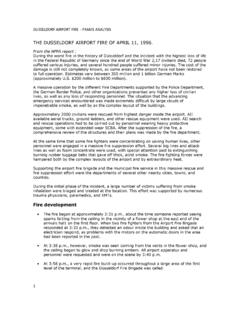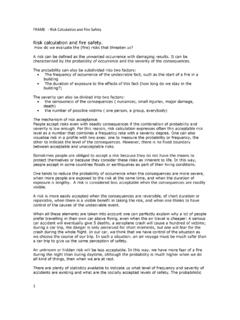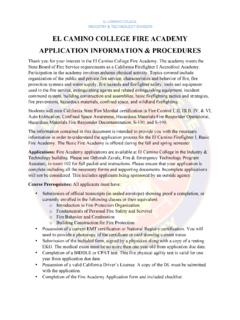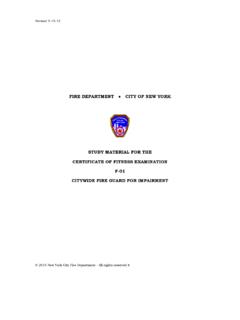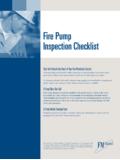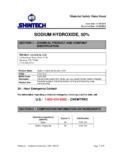Transcription of A qualitative fire risk assessment method
1 FRAM-ini a qualitative fire risk assessment method 13-3-2014. FRAME. Erik De Smet FRAM-ini : a qualitative fire risk assessment method FRAM-ini: a qualitative fire risk assessment method FRAM-ini: a qualitative fire risk assessment method .. 1. 2. Building FRAM-ini .. 2. Inspiration from machinery safety standards .. 2. Input from FRAME .. 3. Limitations .. 4. Property fire risk assessment .. 4. Property Risk assessment Flow Sheet .. 5. fire duration category.. 6. fire growth category .. 7. fire severity .. 7. Building / compartment configuration .. 7. Available fire fighting means .. 8. fire fighting expediency .. 9. Property fire risk class.. 9. Occupant fire risk assessment .. 10. Occupant fire risk assessment flow sheet .. 11. Ignition probability 12. fire growth category.
2 13. Level of 13. Safe egress time margin.. 13. Occupant fire risk class .. 14. Available protection level .. 15. Property risk assessment 16. Occupant Risk assessment worksheet .. 19. 1 16/07/2013 version 1a FRAM-ini : a qualitative fire risk assessment method Introduction. Users of the FRAME semi- quantitative fire risk assessment method expressed the wish for a less elaborate, qualitative fire risk assessment tool for people with a basic knowledge of fire safety. FRAM-ini is the tool developed for this purpose, but it can also be used as an introduction and step stone to the semi-quantitative FRAME approach. Building FRAM-ini Inspiration from machinery safety standards FRAM-ini is inspired by the qualitative risk evaluation method described in the EN10501 and EN954-1. standards for safety of machinery.
3 EN1050 presents a decision tree which uses the severity, the probability of occurrence and the exposure aspects of a potential hazard to define the risk class if no protection would be available. EN. 1050 defines 5 risk classes and EN 954-1 indicates which protection category should be applied for a situation in each class to attain an acceptable level of residual risk. The risk classification is linked to 5. protection levels in the following decision diagram: The 5 protection categories are: Protection category B(asic) means that the system is built according the state of art with good quality materials. This is the minimum allowed for risk class I. Protection category 1 means that the system is built according to the state of art with good quality materials, and the reliability of the safety system is guaranteed by testing, oversizing or duplication.
4 This degree of protection is acceptable for risk classes I and II. Protection category 2 means that the installation meets the requirements of category 1 and the proper functioning of the safety elements is regularly monitored. This degree of protection is acceptable for risk classes II and III. 1. The EN 1050 standard has been replaced by the EN-ISO 14121-1:2007, but the principles remain valid. 2 16/07/2013 version 1a FRAM-ini : a qualitative fire risk assessment method Protection category 3 means that the installation meets the requirements of category 2, a single fault of safety element does not entail the impairment of this function and the fault will be quickly detected. This degree of protection is acceptable for risk classes III and IV. Protection category 4 means that the installation meets the requirements of category 3, a single fault safety function is immediately reported and a multiple fault does not mean that the safety function is switched off.
5 This degree of protection is required for the risk class V. FRAM-ini follows the same approach, and uses a decision tree to classify the fire risks in 5 classes. Input from FRAME. In line with FRAME, there is a separate fire risk evaluation for the property and the occupants 2. As there are many influence factors to be considered in a fire risk risk assessment , weighed checklists were derived from the FRAME sub-factor calculations3. Such checklists allow a balanced evaluation of several parameters to produce sub-classes that are subsequently used in the decision tree process. In FRAME , the recommended approach is to tackle first the property risk assessment and to continue with the occupant risk, as this appears by experience to be the easiest way to define the appropriate overall level of protection.
6 FRAM-ini uses also 5 protection categories, which are defined with the same components as in FRAME, and the link is given between the 5 risk classes and the corresponding adequate protection categories4. The five fire protection categories are: Basic: The users of the building are capable to detect a developing fire , leave the fire scene as necessary and call the fire brigade for help. The fire can be controlled easily. Category 1: There is a basic fire safety plan that tells the users how to react in case of fire and to call the fire brigade for help, and the building is equipped with manual fire alarm and fire fighting means. The fire brigade will intervene according to their standard procedures and be able to control the fire in a short time. Category 2: There is a detailed fire safety plan that tells the users how to react in case of fire , and the building is equipped with an automatic fire detection and alarm system and with manual fire fighting means.
7 The fire brigade has established a specific fire intervention plan for the building. fire control may be difficult under unfavourable circumstances. Category 3: There is a detailed fire safety plan that tells the users how to react in case of fire , and the building is equipped with an automatic sprinklers and and an occupant alarm system. The fire brigade has established a specific fire intervention plan for the building. Category 4: There is a detailed fire safety concept that includes a fire safety plan for the users, a specific fire intervention plan for the fire brigade and manual as well as automatic fire protection systems tailored to the characteristics of the building. 2. A risk assessment for business continuity as in FRAME is considered to be beyond the scope. 3. FRAME uses a large number of elements and sub-factors to produce a quantified risk assessment .
8 4. In FRAME, the adequacy of the protection level is defined by the benchmark value R 1. 3 16/07/2013 version 1a FRAM-ini : a qualitative fire risk assessment method Limitations FRAM-ini can only be used to make a qualitative fire risk assessment . For smaller buildings, the risk assessment can be made for the whole building as one compartment, but for larger buildings, where it is possible to subdivide the building in compartments, it is better to make the fire risk assessment per compartment. When the resulting risk class would be too high, it might be useful to decide first on additional compartmentation and re-assess the fire risk for each of the new compartments. Classifying risks and protections in 5 classes and 5 categories is a mere decision tool. In practice, there is a wide variation of possible damage and a large spectrum of available protection systems.
9 When in many cases the qualitative risk assessment is adequate to take a decision on the required protection level, the diversity of influence factors is so large that a more gradual approach of risks and protections is needed to develop a tailor-made ( fire ) safety concept . In such cases, the FRAM-ini decision tree will result in a Not in scope or non applicable mention. When a quantitative fire risk assessment is necessary, for the definition of an alternative or equivalent fire safety concept, FRAME or a more elaborate method shall be used in agreement with the stakeholders. Property5 fire risk assessment The property fire risk class is defined by a eight steps decision tree. 5 risk classes (RCP I - RCP V). are defined with an increasing damage potential. The risk classes are defined for a fire situation where the fire has to be tackled by the fire brigade by the own means.
10 Automatic fire detection and automatic extinguishing systems are not considered in this stage, but included in the protection category. RCP I : the damage to the compartment and its content is probably limited and repairable RCP II: the damage to the compartment and its content is probably significant but repairable RCP III: important damage in the compartment is likely, but damage to adjacent compartments unlikely RCP IV: total destruction of the compartment likely, damage outside the compartment is also possible RCP V: major fire loss possible Property fire risk class and protection categories are linked in the following scheme: The risk class definition scheme is shown in the following flow sheet: 5. Property means the building and its content. 4 16/07/2013 version 1a FRAM-ini : a qualitative fire risk assessment method Property Risk assessment Flow Sheet 8.
